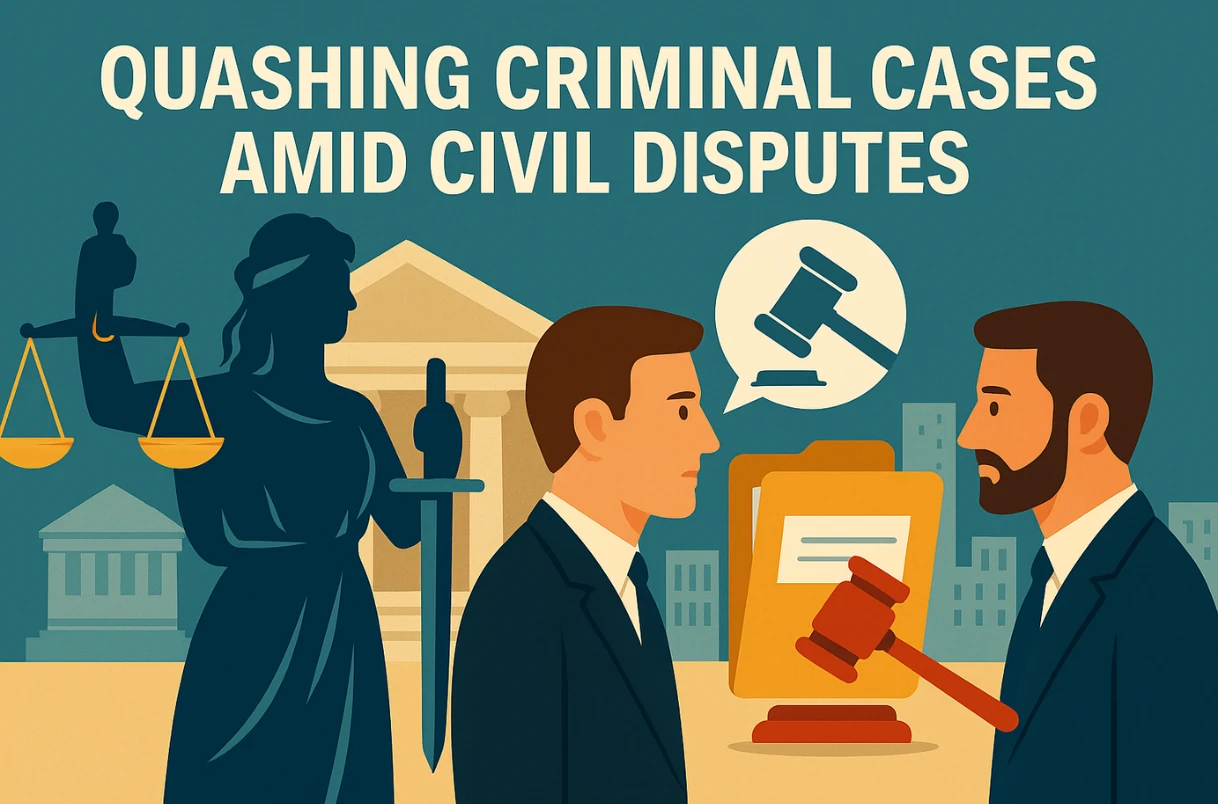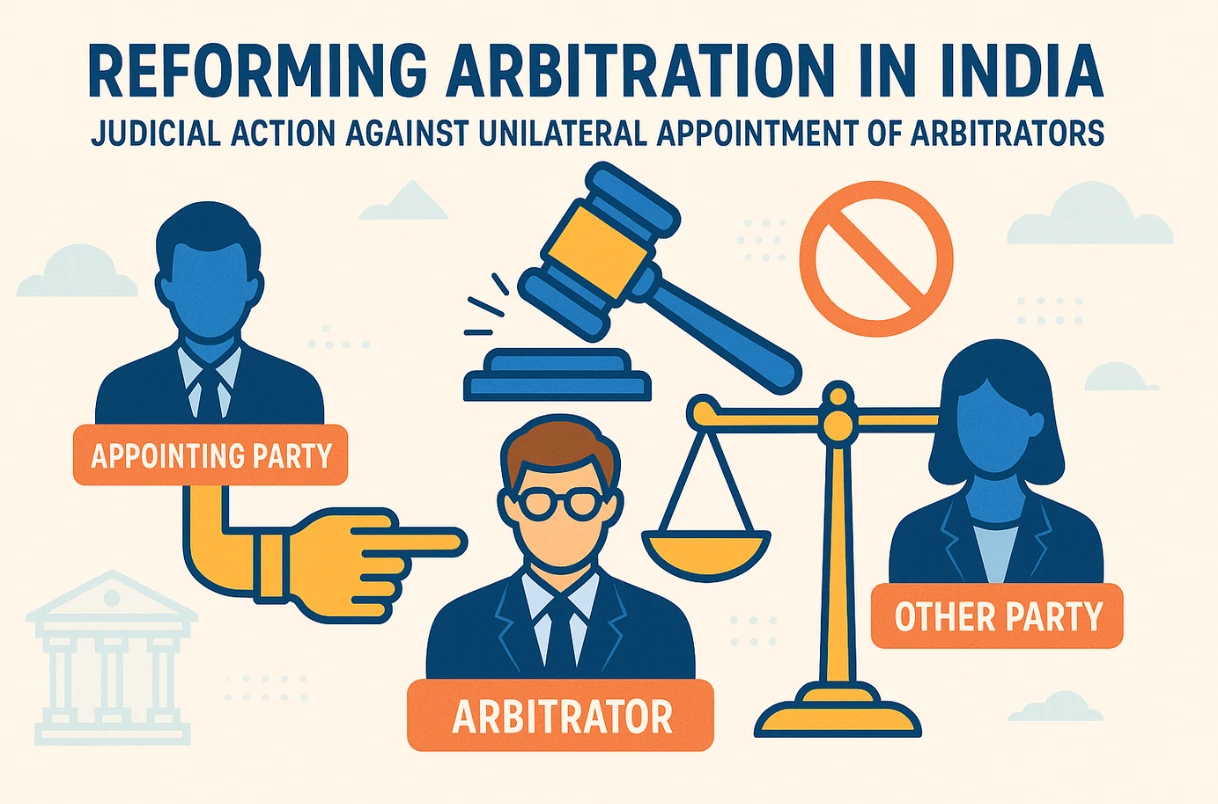Quashing Criminal Cases Amid Civil Disputes – SC Guidelines

By – Shreya Dubey and Nikhil Anand
Table of Contents
Introduction: When Civil and Criminal Remedies Collide
While some litigants deliberately pursue simultaneous criminal and civil remedies qua the same transaction, others are often faced with the question whether pendency of one would impact the other. Those embroiled in criminal prosecution approach High Courts for the exercise of inherent powers to quash the criminal machinery set into motion by the aggrieved complainants. This has been an age-old practice and issue, and there are enough judicial precedents on this subject, with Courts maintaining till date, that there is no bar to simultaneous civil and criminal proceedings.
Judicial Framework: Supreme Court Guidelines in Amit Kapoor v. Ramesh Chander
The principles on this subject were summarised by the Supreme Court in the case of Amit Kapoor vs Ramesh Chander & Anr1 as under:
- Courts should apply the test as to whether the uncontroverted allegations as made from the record of the case and the documents submitted therewith prima facie establish the offence or not. If the allegations are so patently absurd and inherently improbable that no prudent person can ever reach such a conclusion and where the basic ingredients of a criminal offence are not satisfied, then the courts may interfere.
- No meticulous examination of the evidence is needed for considering whether the case would end in conviction or not at the stage of framing of charge or quashing of charge.
- Where there is an express legal bar enacted in any of the provisions of the penal statute or any specific law in force to the very initiation or institution and continuance of such criminal proceedings, such a bar is intended to provide specific protection to an accused.
- Where the allegations made and as they appeared from the record and documents annexed therewith to predominantly give rise and constitute a ‘civil wrong’ with no ‘element of criminality’ and does not satisfy the basic ingredients of a criminal offence, courts must interfere to prevent any miscarriage of justice.
- Where the offence is even broadly satisfied, the courts should be more inclined to permit continuation of prosecution rather than its quashing at that initial stage. The courts are not expected to marshal the records with a view to decide admissibility and reliability of the documents or records but to form an opinion prima facie.
Sector-Specific Trends in Civil-Criminal Overlap
However, with the changing dynamics of litigation, and evolution of sector specific enactments such as Protection of Women from Domestic Violence Act, 2005, the Real Estate (Regulation and Development) Act, 2016, and the Insolvency and Bankruptcy Code, 2016, etc., leading to a complex web of litigations between the same set of parties, courts are not oblivious to the growing problem of vexatious criminal applications being filed to settle personal scores. In family disputes, business circles as well as contractual matters, there has been a consistent growing trend of filing criminal complaints, in a bid to secure a faster settlement of the matter or as a weapon of harassment2. This practice of filing simultaneous proceedings is existing in all spheres of law and is not restricted to contractual matters alone.
Insolvency proceedings
In the insolvency sphere, a new challenge has arisen with the filing of criminal charges against Insolvency Professionals (“IPs”) during the course of Corporate Insolvency Resolution Processes (“CIRPs”). In some recent cases3, IPs have been arrested by investigative agencies, including the CBI, under provisions such as the Prevention of Corruption Act, 1988 despite judicial clarification that they do not fall within the definition of “public servant” under that statute.
Such arrests, often based solely on unproven FIRs without filing of chargesheets, have triggered automatic and indefinite suspensions of IPs by the Insolvency and Bankruptcy Board of India (“IBBI”) until the concerned IP is “exonerated of the charges.” This has given rise to concerns that errant promoters may misuse criminal complaints as a tactical tool to derail ongoing CIRPs, dislodge resolution professionals, and stall resolution timelines.
Matrimonial disputes
Similarly, in the matrimonial context, courts have had to navigate a maze of overlapping civil and criminal proceedings arising from the same relationship breakdown. Until the Domestic Violence Act, 2005 came into force, marriage dissolution proceedings entailed divorce petitions with claims for maintenance. Of late, there has been a surge in simultaneous domestic violence petitions as well. In various instances, the domestic violence law has been found to be misused, to negotiate parting settlements. A striking illustration is the Supreme Court’s recent decision in Shivangi Bansal v. Shahib Bansal4, where multiple litigations including criminal complaints under Sections 498A, 406, 323, 376 of IPC, along with proceedings under the Domestic Violence Act, maintenance claims under Section 125 of CRPC, and divorce petitions under the Hindu Marriage Act, 1955 were simultaneously pending between the parties across different jurisdictions.
The Court observed that while there is no legal prohibition on pursuing both civil and criminal remedies in matrimonial disputes, a large portion of these cases often arise from the same factual substratum and are weaponised to exert pressure on the other side. Emphasising the need for holistic resolution and to prevent abuse of process, the Supreme Court exercised its power under Article 142 to dissolve the marriage, quash all pending litigations (civil and criminal) between the parties and their families, and impose reciprocal undertakings restraining any future legal action on the same issues.
This judgement underscores that while the “overwhelming element of criminality” test must still be applied to assess whether a criminal prosecution should survive alongside civil proceedings, in situations where the disputes are predominantly matrimonial and have been reduced to a cycle of cross-litigation, the Court may step in to bring a complete closure. This is consistent with its approach in Preeti Gupta v. State of Jharkhand5, where vague and omnibus allegations in 498A cases were held to justify quashing to protect parties from vexatious prosecution.
Contractual and property disputes
Even in the contractual domain, it has been noticed that litigants are proactively filing FIR’s against the contracting parties and later pursuing civil remedies. In most cases, civil suits are filed and owning to the slow disposal rate and ineffective interim orders being passed, the litigants decide to change course and simultaneously pursue criminal proceedings. Recently, in the case of S.N. Vijayalakshmi v State of Karnataka6, the Supreme Court in a property dispute was constrained to analyse the terms of the contentious document in question to quash the proceedings against the accused persons. The dispute arose with respect to the sale transaction of a disputed property, in respect of which an Agreement to Sell (“ATS”) had come to be executed by the accused with the complainant in the year 2015 and part consideration having been paid.
Along with the ATS, the accused had also executed General Power of Attorney (“GPA”) acknowledging the execution of the ATS and conferring upon the complainant all powers, including the power to sell the subject property.
Over the course of seven years, the ATS never came to implemented, on the contrary, the accused cancelled the GPA and instead executed a release deed and a fresh GPA in favour of the co-accused in the year 2022. The complainant first instituted a civil suit to declare the subsequent GPA and Release Deed as not binding and also seeking specific performance of the ATS.
Simultaneously, the complainant also initiated criminal proceedings and an FIR on cheating and criminal breach of trust came to be registered in the year 2024.
More often than not, in similar cases, this is the most common route adopted by complainants, where the disputed subject matter (subject property in this case) is under threat of a third party transfer or alienation.
The question is, what of the criminal route taken in such cases, when the civil prosecution would ultimately give finality to this lis between the same set of parties. This was precisely the question under the quashing petition preferred by the accused persons as to whether on the same cause of action, both civil and criminal proceedings could simultaneously be pursued by the complainant?
The Supreme Court, as recent as 31.07.2025 continues to uphold that there is no bar to simultaneous civil and criminal proceedings, with the rider that:
“The test is such cases that, the allegations even if having a civil flavour to them, must prima facie disclose an “overwhelming element of criminality”…If the element of criminality is there, a civil case can co-exist with a criminal case on the same facts. The fact that a civil remedy has already been availed of by a complainant, ipso facto, is not sufficient ground to quash an FIR”
Consequently, after examining the ATS in question, the Supreme Court quashed the FIR, premised on the fact that the offence of criminal breach of trust was not made out against the accused appellants, as the subject property was not entrusted to the accused persons, but was their own and the ATS postulated that possession of the subject property would be handed over in ready condition only upon execution of the Sale Deed by the accused persons.
Testamentary disputes
Recently, even in the matter of a will, the Supreme Court in the case of Urmila Devi & Ors v. Balm & Anr7 quashed a criminal case pending for over 20 years filed by relatives inter-se over allegations of forged will.
Supreme Court observed it to be just another case in a string of cases filed in recent years that seek to disguise a civil dispute as criminal, holding that its continuation would not serve any purpose.
Therefore, while the earlier practice was examining prima facie if an element of criminality existed warranting continuance of criminal investigation during the pendency of civil prosecution, times have evolved requiring a deeper examination of the lis between the same set of parties to analyse the unnecessary criminal flavours given to civil disputes. Needless to say, the Indian courts have not shied away from this approach, as can be seen from recent judicial precedents.
The “Overwhelming Element of Criminality” Test: Judicial Meaning and Ingredients
Now the concept of “overwhelming element of criminality” has not been defined anywhere, but the same has been deliberated in many precedents to be such allegations that are not vague and carry the essential ingredients to constitute the offences alleged. “Overwhelming” denotes something so strong or dominant that it conclusively outweighs any countervailing inference. The criminal features must be so prominent that the matter is incapable of being viewed as a purely civil transaction. Under criminal law, an “element” refers to a fact or component that must be proven beyond reasonable doubt to establish a conviction. It is premised on:
- Actus Reus (guilty act): the prohibited act/omission.
and
- Mens Rea (guilty mind): the relevant intention or mental state.
“Criminality” in law refers to conduct that involves both actus reus and mens rea, and is punishable under criminal law. “Overwhelming element of criminality” would thus mean to include such conduct both in actions and intent, making it obvious that the matter belongs to the criminal domain, not merely as a civil disagreement.
The “Overwhelming Element of Criminality” Test: Judicial Meaning and Ingredients
Another question that surrounds the topic of discussion, is the stage at which such quashing petitions are usually preferred. The quashing of criminal prosecution during pendency of a civil dispute is largely dependent on the stage of criminal prosecution as well. As explained in the case of Amit Kapoor v. Ramesh Chander8:
“25. Having examined the interrelationship of these two very significant provisions of the Code, let us now examine the scope of interference under any of these provisions in relation to quashing the charge. We have already indicated above that framing of charge is the first major step in a criminal trial where the court is expected to apply its mind to the entire record and documents placed therewith before the court. Taking cognizance of an offence has been stated to necessitate an application of mind by the court but framing of charge is a major event where the court considers the possibility of discharging the accused of the offence with which he is charged or requiring the accused to face trial.
There are different categories of cases where the court may not proceed with the trial and may discharge the accused or pass such other orders as may be necessary keeping in view the facts of a given case.
In a case where, upon considering the record of the case and documents submitted before it, the court finds that no offence is made out or there is a legal bar to such prosecution under the provisions of the Code or any other law for the time being in force and there is a bar and there exists no ground to proceed against the accused, the court may discharge the accused. There can be cases where such record reveals the matter to be so predominantly of a civil nature that it neither leaves any scope for an element of criminality nor does it satisfy the ingredients of a criminal offence with which the accused is charged. In such cases, the court may discharge him or quash the proceedings in exercise of its powers under these two provisions.”
Partial Criminality: When Quashing Is Only Partly Justified
Another category of cases are those where criminal charges are only partly made out. In such cases, it is the duty of the court to segregate the non maintainable charges from the maintainable ones. One such example is the case of M/s Indian Oil Corporation v. M/S NEPC India Ltd., & Ors9, where despite multiple civil suits and ongoing recovery and winding up proceedings pending between the contracting parties, the Supreme Court held that criminal law remedies are not barred, but quashing was justified only where the essential ingredients of the alleged offences were missing. All charges of criminal breach of trust, dishonest misappropriation of property, and theft were quashed by the Supreme Court but allegations of cheating and mischief in the complaint were found sufficient to be constituting offences under sections 415 and 425 of IPC.
The Supreme Court thus partly allowed the appeal and directed the trial court before whom the matters were pending, to proceed with the matters in accordance with law in so far as offences under sections 415 and 425 of IPC alone were concerned.
This position is consistent with Madhavrao Jiwajirao Scindia v. Sambhajirao Chandrojirao Angre10, where the Court held that criminal cases should be quashed where the chances of ultimate conviction are bleak and no useful purpose would be served by continuing the prosecution.
Conclusion: Balancing Civil Justice and Criminal Process
As can be seen from the above discussions and relied upon precedents, Courts have attempted to balance the freedom of a person and the right of the complainant to investigate and prosecute the offender. This balance is often very delicate and Courts are having to delve deeper into merits of such petitions in order to set bonafide cases apart from frivolous litigation.
It is a settled law that the inherent power of the High Court cannot be invoked merely to stifle or scuttle a legitimate prosecution, the factual foundation and ingredients of each offence have to be satisfied in each instance.
It is not just a prima facie case that needs to be established but one where the allegations, taken at their face value, clearly disclose the commission of an offence and satisfy all its statutory elements. The Court must be convinced that the matter is not inherently improbable, nor a purely civil dispute given a criminal colour to gain collateral advantage.
A criminal case will not be automatically quashed merely because a related civil dispute is pending. However, it may be quashed where the allegations lack any criminal element and the simultaneous continuation of both proceedings would amount to an abuse of the court’s process.
Therefore, while the pendency of civil proceedings on the same facts cannot, by itself, be a ground to terminate a criminal prosecution, the Court will intervene where continuation of the criminal case would result in miscarriage of justice, amount to abuse of process, or where the dispute is predominantly civil and the criminal allegations lack the necessary “overwhelming element of criminality.” In such circumstances, the Court may quash the proceedings to prevent harassment, while ensuring that genuine cases of criminality proceed to trial.
FAQs
-
What does “quashing of criminal proceedings” mean in Indian law?
Quashing of criminal proceedings refers to the power of High Courts to terminate a pending criminal case at any stage if it appears to be frivolous, malicious, or an abuse of legal process. Under Section 482 of the Code of Criminal Procedure (CrPC), courts can intervene to prevent miscarriage of justice, especially when the allegations fail to disclose a criminal offence or the continuation of the case serves no legitimate legal purpose.
-
Can civil and criminal cases be pursued simultaneously in India?
Yes, Indian law allows for simultaneous civil and criminal proceedings arising from the same set of facts. The Supreme Court has clarified in multiple judgments that there is no legal bar to this, provided the criminal complaint discloses the necessary ingredients of the alleged offence. However, courts scrutinize whether the criminal case is being used to pressurize the other party or to gain an upper hand in the civil dispute.
-
What is the “overwhelming element of criminality” test?
This test is applied by courts to determine whether allegations – despite having a civil flavour-disclose clear and serious criminal conduct. It requires that both actus reus (guilty act) and mens rea (guilty mind) be clearly present in a way that outweighs any civil aspect of the dispute. If the criminality is merely incidental or vague, the court may quash the case.
-
Which Supreme Court judgments guide quashing of criminal proceedings?
Key judgments include Amit Kapoor v. Ramesh Chander, which lays down comprehensive principles for quashing; Preeti Gupta v. State of Jharkhand, which addresses misuse of 498A IPC in matrimonial matters; Madhavrao Scindia v. Sambhajirao Angre, which supports quashing where conviction is unlikely; and Indian Oil Corporation v. NEPC India Ltd., which emphasizes partial quashing based on maintainability of charges.
-
When can High Courts use their inherent powers under Section 482 CrPC?
High Courts may invoke Section 482 CrPC to quash a case when the allegations are absurd, do not disclose a cognizable offence, are legally barred, or when continuing the prosecution would amount to abuse of the court’s process. This power is used cautiously, especially when the case involves mixed civil and criminal elements.
-
How do courts prevent misuse of criminal law in civil disputes?
Courts look beyond the mere framing of charges and assess the underlying intent and content of the complaint. If the criminal proceedings are found to be tools of harassment, filed with the motive of coercion, or merely duplicative of ongoing civil cases, courts may intervene to quash them. The goal is to ensure that criminal law is not misused as a bargaining tactic.
-
Can matrimonial disputes involve both civil and criminal proceedings?
Yes, matrimonial disputes frequently involve both. Alongside civil proceedings like divorce or maintenance claims, parties often initiate criminal complaints under Sections 498A, 406, or the Domestic Violence Act. Courts, however, closely examine whether such criminal cases are genuine or weaponised to extract settlements or cause undue harassment.
-
What role does the stage of trial play in deciding quashing petitions?
The timing of the quashing petition significantly affects judicial discretion. If charges are yet to be framed and the complaint lacks legal or factual basis, courts are more likely to intervene. However, once the trial has progressed, courts are less inclined to quash unless there’s a clear abuse of process or legal bar.
-
How does the Supreme Court distinguish civil wrongs from criminal offences?
The Supreme Court looks at whether the essential ingredients of a criminal offence – particularly criminal intent – are present. If the dispute primarily concerns contractual terms, property rights, or other civil issues and lacks any dishonest or fraudulent intent, courts may conclude that it is a civil wrong dressed up as a criminal case.
-
Can a criminal case be quashed if chances of conviction are weak?
Yes, courts have held that if the chances of conviction are extremely remote or bleak, continuing the trial serves no meaningful purpose. In such cases, especially where the allegations are vague or lack necessary evidentiary support, the court may quash the proceedings to avoid unnecessary harassment and waste of judicial resources.
References –
- (2012) 9 SCC 460
- Usha Chakraborty v State of West Bengal: (2023) 15 SCC 135
- Order dated 02.03.2021, Civil Appeal No. 3395 of 2020; Dr. Arun Mohan Vs. Central Bureau of Investigation, W.P.(CRL) 544/2020
- T.P. (C) No. 2367 of 2023
- (2010) 7 SCC 667
- Special Leave Petition(Criminal) No.8626 of 2024, Order dated 31.07.2025
- CRIMINAL APPEAL NO. 3300 OF 2025 , Judgement dated JULY 31, 2025
- (2012) 9 SCC 460
- AIR 2006 SUPREME COURT 2780
- 1988 SCR (2) 930


